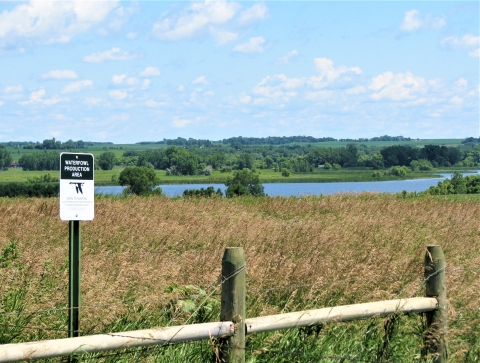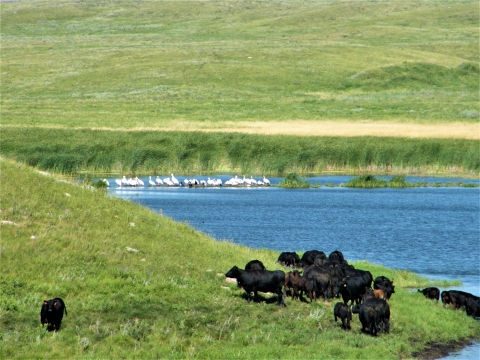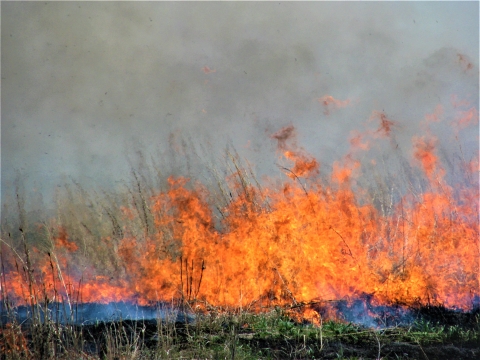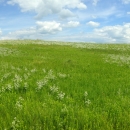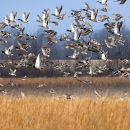What We Do
Wildlife conservation is at the heart of the National Wildlife Refuge System. It drives everything on U.S. Fish and Wildlife Service lands and waters managed within the Refuge System, from the purposes for which a national wildlife refuge national wildlife refuge
A national wildlife refuge is typically a contiguous area of land and water managed by the U.S. Fish and Wildlife Service for the conservation and, where appropriate, restoration of fish, wildlife and plant resources and their habitats for the benefit of present and future generations of Americans.
Learn more about national wildlife refuge is established to the recreational activities offered to the resource management tools used. Using conservation best practices, the Refuge System manages Service lands and waters to help ensure the survival of native wildlife species.
Management and Conservation
Madison Wetland Management District sits at the western edge of the Tallgrass Prairie Region, the most threatened ecosystem in North America. Because agriculture and land development have changed the landscape, District staff use a variety of management tools to mimic natural processes.
Waterfowl Production Areas:
Waterfowl production areas are public lands purchased with Federal Duck Stamp dollars. Many waterfowl production areas are small, ranging in size from as little as 10 acres to nearly 2,000 acres. They are often broadly dispersed over many counties in the Prairie Pothole Region. More than 3,000 waterfowl production areas have been purchased since 1958 when Congress authorized the use of Duck Stamp dollars for purchasing small wetlands.
Grazing:
Historically, bison roamed the prairies in massive herds, eating and trampling grass and adding nutrients to the soil as they moved through an area. Today, District staff use other grazers, primarily cattle, to help manage grasslands. When used properly, grazing is a useful tool for controlling invasive species invasive species
An invasive species is any plant or animal that has spread or been introduced into a new area where they are, or could, cause harm to the environment, economy, or human, animal, or plant health. Their unwelcome presence can destroy ecosystems and cost millions of dollars.
Learn more about invasive species , reducing dead plant material, and increasing nutrient cycling, all of which improve a stand of grass. Since the U.S. Fish and Wildlife Service doesn't own livestock, we use special use permits with ranchers and they graze their cattle on the land for a set time period. Ranchers benefit by resting some of their pastures and the U.S. Fish and Wildlife Service gets improved habitat for wildlife.
Upland Restoration:
Some of the grasslands we manage are native prairie - they have never been plowed up and have many native species. Other grasslands may have been plowed up and planted to crops or tame grasses for pasture or hay. These grasslands may have only one or two species of plants and may be infested by invasive species and weeds. District staff work to restore these areas with native grass and flower species. The easiest way to accomplish this is to plant it with crops for a few years to get a clean seed bed. Ten to fifty grassland species are then planted and nurtured for the next few years. Though this is a far cry from native prairie, these areas provide more diversity and structure for wildlife habitat than unrestored lands.
Grasslands definitely benefit from management that removes the vegetation, but doing it too much or too often is not a good thing. For this reason, managers sometimes use rest as a management tool.
Wetland Restoration:
Restoring wetlands is intensive - it involves restoring drained wetlands and natural runoff, reducing siltation and erosion, and re-establishing native vegetation. The U.S. Fish and Wildlife Service also provides assistance to private landowners who wish to restore or enhance their lands for the benefit of wildlife and natural resources. This assistance is provided through the Partners for Fish and Wildlife Program.
Prescribed Burning:
Prescribed burning is used to remove dead vegetation, release nutrients back to the soil, decrease woody and other invasive plants, increase warm-season plants, and reduce organic litter on the surface. Most burns occur during April, May, and June. Upland burns at this time set back invading cool-season plants, such as smooth brome and Kentucky bluegrass.
Conservation Easements:
The Migratory Bird Hunting and Conservation Act, also known as the Duck Stamp Act, authorizes land purchases with funds from the sale of Federal Duck Stamps to conserve migratory birds, especially waterfowl (ducks, geese, and swans). Under this program, the U.S. Fish and Wildlife Service can both purchase lands and enter into conservation easements with private landowners to protect migratory bird habitat.
Law Enforcement
In years past, unlimited harvests could wreak havoc on wildlife populations. Federal Wildlife Officers play a critical role in protecting wildlife and habitat as well as the visiting public. The Mission of the Office of Law Enforcement is to protect wildlife and plant resources. Through the effective enforcement of Federal laws, we contribute to Fish and Wildlife Service efforts to recover endangered species, conserve migratory birds, preserve wildlife habitat, safeguard fisheries, combat invasive species invasive species
An invasive species is any plant or animal that has spread or been introduced into a new area where they are, or could, cause harm to the environment, economy, or human, animal, or plant health. Their unwelcome presence can destroy ecosystems and cost millions of dollars.
Learn more about invasive species , and promote international wildlife conservation.



